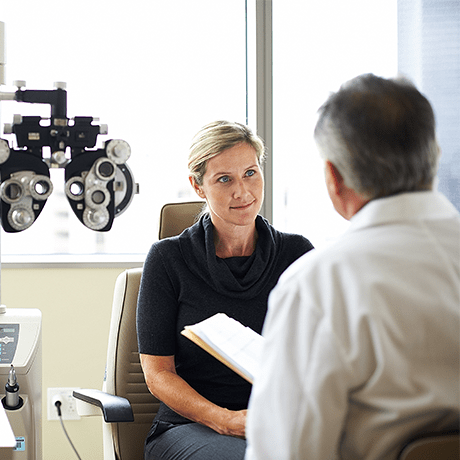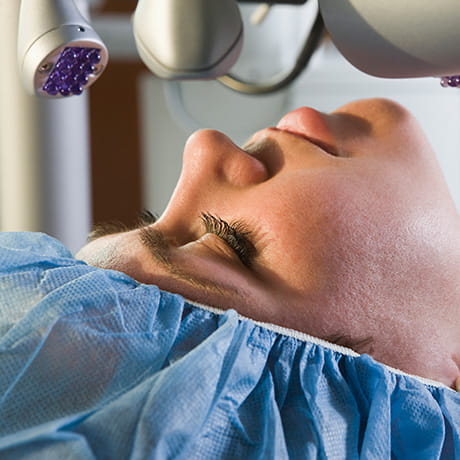
Preparing for LASIK
Learn more about what to expect before, during and after your surgery through recovery.
When it comes to your vision, there’s no room for compromise — you want the confidence that your surgeon is using equipment and procedures that are state-of the-art. That’s why you can entrust your vision to The Ohio State University Wexner Medical Center, where our experts have decades of experience providing LASIK surgery to patients in Columbus, Ohio.
Don’t have MyChart? Create an account
LASIK surgery is done to correct refractive errors. This is when vision becomes blurry because the cornea, the clear front part of the eye, is shaped abnormally and light doesn't bend, or refract, properly as it reaches the retina in back of the eye. Refractive errors can include:
LASIK can correct these vision problems. In some cases, laser surgery for refractive errors may reduce or eliminate the need for eyeglasses or contact lenses.
As the natural lens inside the eye ages, it can lead to decreased near vision (presbyopia). This results in the need for reading glasses. LASIK doesn’t correct presbyopia; however, monovision (also called “blended vision”) is a possible treatment option. Your doctor will correct one eye to see distance and one eye to see close up. Discuss monovision with your physician.
If you’re doing research about LASIK, you’ll read a lot about the benefits of the surgery itself: little to no pain, immediate vision correction and quick recovery times.
The true benefits of LASIK eye surgery are the changes it makes in your life. No more reaching for glasses in the morning to read the clock or buying bottles of contact lens solution. No more frames sliding off your nose on a hot day or losing a contact in the middle of your workout. No more choosing between glasses or contacts on your vision insurance benefits when you really need both. LASIK means hassle-free vision, all the time. It’s just you and your own eyes.
At the Ohio State Wexner Medical Center, we use advanced, all-laser technologies, which offer considerable advantages over traditional procedures. The Ohio State Wexner Medical Center’s experienced surgeons use the most advanced technologies to diagnose corneal issues and perform surgical procedures. Our surgeons measure the optical distortions of the cornea and produce a map showing how light is distorted in your eye. This highlights individual imperfections and tailors laser settings for the best results, including improved nighttime vision.
Our experts are also backed by the resources, research, education, technology, teamwork and reputation of the Ohio State Wexner Medical Center. We are tirelessly dedicated to patient safety, and our surgeons strive to give every patient first-class service and the highest-quality result.
The Ohio State Wexner Medical Center eye care specialists provide a thorough, free evaluation to determine whether you’re a good candidate for LASIK, and they’ll support you every step of the way.
During your evaluation, our doctors will familiarize you with all the benefits of our LASIK process, but the most exciting feature of the Ohio State Wexner Medical Center LASIK is our topography-guided laser vision correction.
Our LASIK system maps the surface of your eye, giving us the ability to develop a unique vision correction plan for you. Rather than simply treating your vision based on your eyeglass prescription, we can pinpoint and correct the smallest imperfections of your cornea and its curvature. The result is a personalized focusing surface for each patient and each eye. Many patients experience better-quality vision following a LASIK procedure than they ever had with contacts and glasses.
Once the procedure begins, patients won’t need to move around from laser to laser. Our patient table shifts from the laser that prepares your eye for correction to the one that corrects your vision. This connectivity makes the entire procedure faster and more precise, making you more comfortable.
Our new LASIK system represents a significant advance in laser vision correction. LASIK has never been faster, safer or more accurate. If you’ve been waiting for the right time to have LASIK, make the choice to start today.
At Ohio State Havener Eye Institute, we perform state-of-the-art, blade-free, all-laser LASIK for the best vision outcomes. We currently use the latest technologies, such as the WaveLight Refractive Suite, which includes the FS200 Femtosecond laser for flap creation and the Excimer 500 laser for personalized vision correction. This allows our surgeons to serve a wide variety of patient needs.
The FS200 Femtosecond laser creates a much thinner corneal flap as compared to a flap created with a microkeratome (handheld blade). Patients who were previously told their corneas were too thin for LASIK may now be eligible for the treatment.
The WaveLight laser customizes every treatment to the patient’s individual prescription and cornea. This personalized treatment enhances the quality of vision and also addresses any distortions that may affect night vision. Recent studies indicate that with wavefront-optimized technology, patients are more likely to achieve 20/20 vision.
LASIK laser technology continues to make important advancements, but there’s no substitute for experience. Ohio State’s David Castellano, MD, has been performing LASIK surgeries for 20 years. Together with colleagues Amit Tandon, MD, and Rebecca Kuennen, MD, the Ohio State Wexner Medical Center brings nearly 40 years of combined LASIK experience to each procedure.
“We provide very personalized care," Dr. Castellano says. "You’ll always see me directly when you make an appointment at my office. Most of my patients have my cellphone number and can reach me anytime. If a patient has a problem, I’ll always make time to see them.
“And working at Ohio State offers many opportunities to stay on the leading edge of eye care. I just keep learning.”
At Ohio State Havener Eye Institute, our doctors are here to help you make the most-informed decision about your vision, to answer your questions and to address your concerns.

Learn more about what to expect before, during and after your surgery through recovery.

Schedule your free LASIK consultation with the eye care experts at the Ohio State Havener Eye Institute.

We offer several financing options for LASIK to match your budget.
Prescriptions for eye drops will be electronically sent to your pharmacy. These drops will be used after the surgery. Any questions about your drops should be directed to the main number: 614-366-1270.
You must have a responsible adult that you know bring you to the surgery, preferably stay in the facility or at least check in with you and provide a contact number, and drive you home.